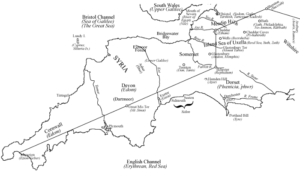Erythraean Sea
The Erythraean Sea as referred to by Herodotus (Histories Bk I.202) derives its name from the Greek for ‘red’. To the ancient Greeks ‘Erythraean’ was a term used to refer to the Red Sea as well as the Persian Gulf and Indian Ocean. There is an ancient Persian tradition(a) that the Phoenicians migrated from the shores of the Erythraean Sea. This view is echoed at the very beginning (I.1) of The Histories of Herodotus.
The 1st century AD Periplus of the Erythraean Sea[1214] (translation by W.H. Schoff) makes it quite clear that the term refers to the region of the Indian Ocean. This can be read online(b).
Michael A. Cahill contends[0819.751] that the Black Sea was the Erythraean Sea referred to in the Book of Enoch.
Even more ‘exotic’ is the claim by W.C. Beaumont (see map) that the English Channel was in fact the Erythraean or Red Sea, along with the relocation of many other places mentioned in Exodus to sites in Britain.
Sea, along with the relocation of many other places mentioned in Exodus to sites in Britain.
It is claimed by some writers that Erythraean is an alternative name for the ‘Sea of Atlantis’. R. Cedric Leonard offers the following translation “but the Caspian Sea is by itself, not connected to the other sea. For the sea navigated by the Greeks, also that outside the Pillars called the Atlantis Sea and the Erythraean, are one and the same”. Both Leonard and Anton Mifsud claim that this passage demonstrates that Herodotus identified the Erythraean with the Atlantis Sea. However, a careful reading of the context clearly shows that what Herodotus was describing was the extent to which the world’s oceans were connected, even though the Caspian was landlocked. Africa had already been circumnavigated eastward from Egypt on the instruction of Pharaoh Necho II around 600 BC demonstrating the connection between the Mediterranean and the Red Sea. Furthermore, the mention of ‘the sea navigated by the Greeks’ is probably a reference to the eastern Mediterranean, placing the Pillars of Heracles in the vicinity of Malta. This would identify the western Mediterranean and/or Tyrrhenian Sea as the ‘Sea of Atlantis’ complementing Plato’s description of Atlantis extending as far as Tyrrhenia and Libya. It is worth noting that Giorgio Grongnet de Vasse envisaged the Island of Atlantis occupying the Gulf of Syrtis off the coast of Libya and designated the sea to the west of Malta as ‘Mare Atlantico Antico’ or the ancient Atlantic Sea.
